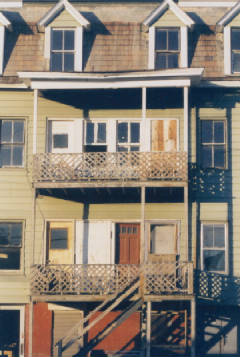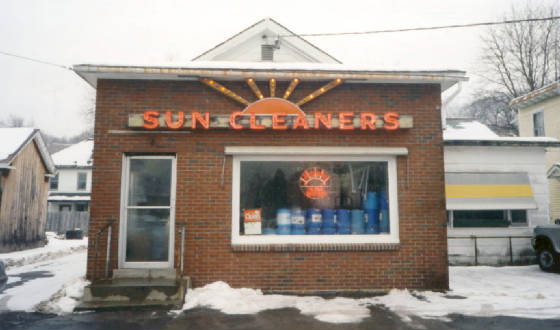
“Someday, that’s going to be Fifth Avenue.” -comment often attributed to Tom Krens, Mass MoCA founder, while looking at River Street from the windows in Building 5.
The word around town lately is that all the houses on River Street from Houghton to Brown may be demolished within a year or two to make way for hotels, motels and other commercial ventures. The resounding success of Mass MoCA is not only bringing in tourists, high tech companies, and homebuyers, but it is also bringing back the bulldozer and the crane.
About 25 years ago, those weapons of mass destruction finally rolled out of town after leveling most of the south side of Main Street over a four-year period. Urban renewal demonstrated how folly looks like wisdom when there is plenty of money to back it up. After the money ran out and the huge empty lot didn’t attract any major-league developers, it looked like folly again. As someone once said, “The only thing we learn from history is that we don’t learn from history.” River Street, here we go again.
This time, however, it’s not the bulldozer and the crane we should fear; it’s the cookie cutter. The temptation now is to replace everything that doesn’t look like success with anything that does, even if it looks like every other town. A walk down River Street is no “walk in the park,” but to this writer, it is well worth taking. I did so on a sunny, cold late afternoon just before Christmas.
Starting at Eagle Street, the first thing I notice is the abundance of auto body and auto maintenance shops on the left. These colorless buildings are functional in the most literal sense. They look just like we expect them to. They are typical of the type of buildings that are common along a major route on the outskirts of almost any American city or town. When we are traveling, we know we are close to civilization when they appear.
On the right, there is an assortment of one-family and multi-family homes, one with rusty colored ivy all over it, the Tabernacle Church in an enormous barn-like white structure, and a large tenement with a mansard roof and plenty of dormers. Located between 51 and 65 River Street (the house number is missing), this tenement is in terrible shape, but the variety of makeshift repairs gives it a oddly beautiful multi-colored appearance. When I stop to take a picture of it, two teenage girls get out of a car in front of a nearby house, and one yells out, “Are they gonna tear down that building?” It looks that way, and I would be sad to see it go. Strangely, there’s a business sign on the house next door that says, “Timeless Treasures.”
Near the corner of Houghton Street, the neon “sun sign” on Sun Cleaners looks so endearingly small town. So does the Corner Store, whose shape actually sharpens into a corner as it gets closer to the river. Across the street, Lou’s Hot Dog Heaven announces its grand opening. Looking up Houghton, I see the changes coming. The three-story blue tenement next to the empty lot waits for its demise. Facing it, the unique Climax Candy building, tired and old, is getting a vinyl siding makeover. Soon it will look like nothing in particular.
Below, the River Street Package Store seems busy as always. Does anyone driving down Houghton ever notice the odd false front rising high above the second story? Why did they build it that way? On the opposite corner, the fenced-in pool store has a face only a mother could love. From that point to Brown Street, I make the long journey past the massive Sprague buildings and the river on the left, and on the right, and the deteriorating remains of mill housing that have been sitting in the shadows of the clock tower for more than a century.
Imagine living there in the late 1800s. Coal-burning stoves and wood-burning fireplaces spew black smoke into an early April morning sky. The snowmelt from the mountains feeds the river as it rages by. Arnold Print Works and the surrounding mills chug away, the endless sounds silenced only by trains and horse-pulled wagons. Imagine 1927, when the great flood came. Tony Talarico was 13 years old then and still remembers it.
“When we had the flood in 1927, my father had his tailor shop on Holden Street right near Main Street. My cousin was working over at the Arnold Print Works and came over about five o’clock in the afternoon. I was at the tailor shop, and my mother was there, too. My uncle couldn’t cross the Marshall Street bridge because the water was going over it. He told my father that we’d better go home. So we got in my father’s car, came up Center Street, and when we got on Eagle Street, the water was up above the hubcaps. We crossed Union Street, and a big log came down and just missed the car. River Street was like a regular river.”
“We lived on Harris Street, which is off River Street. At the foot of Harris Street, there was a store. The water was so strong, that it took that store and turned it around and floated it down the river. There were about three tenement blocks right after Harris Street. The water began to eat away at the first tenement block. All the people in the houses put planks from one tenement block to the other and crossed over to the center of the middle tenement. The fire department came over and put a ladder across River Street, which was like a rushing torrent. People were screaming. I can still hear it.”
Another flood in 1938 was a virtual rerun. Several years later, the River Street people saw Arnold go out and Sprague come in. When Pearl Harbor was attacked, sons of River Street were carried off to war on outbound trains that disappeared into the valley. In the early 1950s, one could watch from River Street windows as the Army Corps of Engineers tore up the riverbanks and installed the flood control chutes. In 1986, all went quiet as Sprague closed. For those who still remembered the old days, the river no longer raged, the clock tower no longer rang, and the trains seldom whistled in the night.
River Street is the home of the Harvest Soup Kitchen and the Salvation Army. It is no Fifth Avenue. I see the familiar signs all the time. Front doors lay open in tenements and houses, exposing baby carriages and rusty bicycles under stairwells. Sheets of clear plastic cover second-floor windows, and young men smoke cigarettes and work on old cars. But life must go on, even for these struggling people who are as much a part of this city as anyone. One house near the Brown Street bridge looks so faded, it’s a wonder it hasn’t simply vanished.
Walking in this area of River Street perhaps a 100 times over the past three years, I have followed the renovation and conversion of Sprague Electric into Mass MoCA. Windows are replaced, paint of matching colors is applied, and brick walls are restored. But across the river, the houses continue to fall apart. Window frames are left to rot, paint peels off, and porches sag. I can remember many times looking out the windows in Building 5 at MoCA and being swept away by the beauty of these houses, especially the long row of five or six directly across, their roof lines an art work in itself. I roam the galleries often, and I have seen the visitors stare at the same view. What are they thinking? Someday, they may be staring at cars winding in and out of a Wendy’s drive-thru.
When urban renewal took the YMCA building on Summer Street in 1971, the residents, mostly elderly single men, had to have somewhere to go. It took a long time to relocate them. What will happen to the residents of River Street if they are forced out by a Kentucky Fried Chicken, a Days Inn, or a swanky hotel? Suddenly, it’s the tourists we care about. Mass MoCA will bring them, and we will have to wine and dine them and bed them down.
The folks at Mass MoCA converted Sprague Electric into a museum without taking away its mill character. Will we follow their example, or will we once again haul out our history to a landfill? Will we find a way to give new life to these houses of our ancestors and new hope to their occupants as well, or will we just peddle our memories and our character to the highest bidder?
If predictions hold true, the 21st century will bring in many more summer visitors with their cash and credit cards. Most will also bring their cameras. Will there be anything to aim the camera at? Will we still look like North Adams?
|
|
|
|

